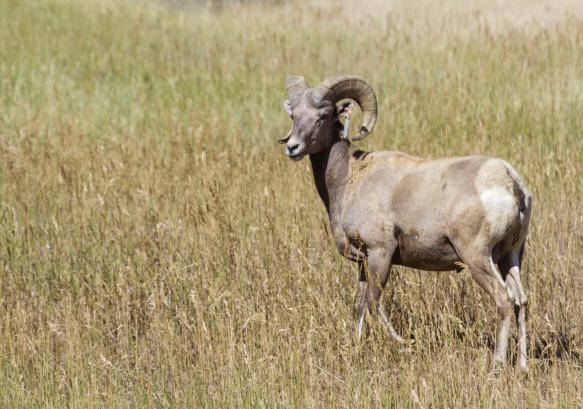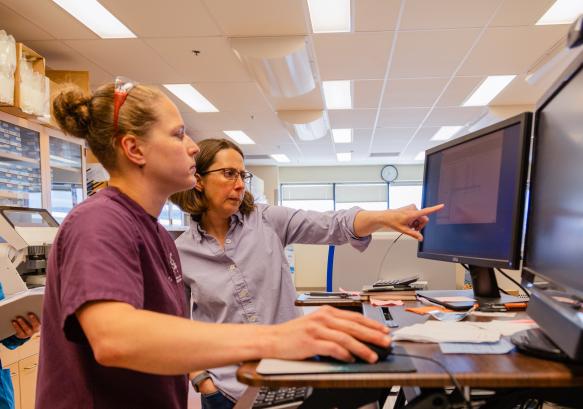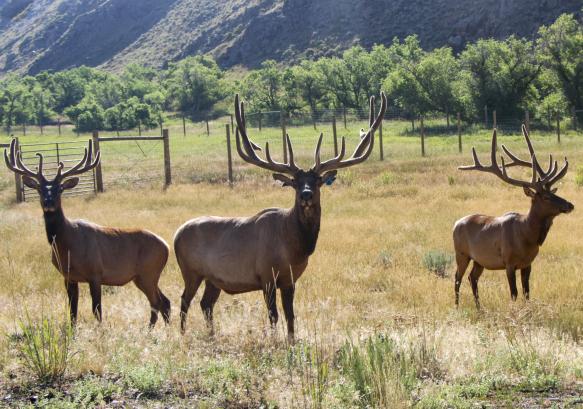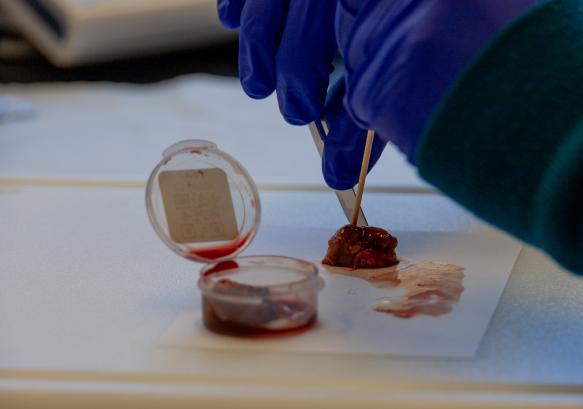
Wildlife Disease and Health
The Wyoming Game and Fish Department monitors and researches a variety of wildlife diseases. Improving our knowledge of diseases, including their prevalence throughout the state and their mechanisms of transmission, allows us to better understand how they may impact wildlife populations. This information is used by managers to better conserve Wyoming's wildlife.

Highly Pathogenic Avian Influenza
The Centers for Disease Control and Prevention (CDC) states that the recent HPAI detections in birds do not present an immediate public health concern. HPAI cases in humans are rare, and symptoms are typically mild. While the risk of a person becoming infected is low, hunters may be at higher risk from handling waterfowl. To minimize your risk, follow the precautions from the USDA-APHIS listed in this HPAI PDF.
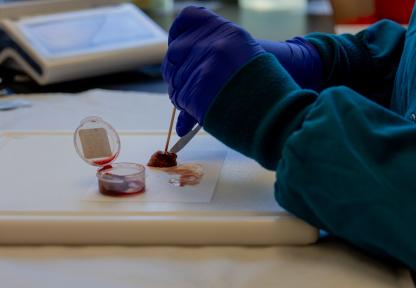
Chronic Wasting Disease
Chronic Wasting Disease (CWD) is a chronic, fatal disease of the central nervous system in mule deer, white-tailed deer, elk, and moose. CWD was first detected in Wyoming in 1985, and can now be found across the majority of the state. The Wyoming Game and Fish Department monitors select hunt areas for CWD each year to determine disease prevalence.
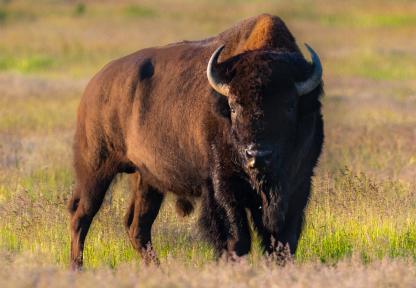
Brucellosis
Brucellosis is a bacterial disease that primarily affects elk and bison. After infection, cows often abort their first fetus, and sometimes will also abort subsequent pregnancies. Brucellosis also infects domestic cattle. An eradication program has almost eliminated the disease in cattle, but infected elk and bison pose a continuing threat.
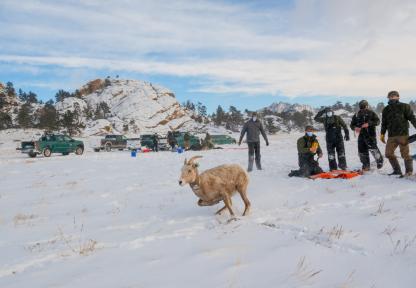
Bighorn Sheep Pneumonia
Respiratory disease is a leading cause of population declines in bighorn sheep in the western United States. Sporadic outbreaks of pneumonia cause large die-offs, often followed by multiple years of poor lamb survival. The Wyoming Game and Fish Department has been conducting statewide bighorn sheep herd health surveillance since 2011.
Other wildlife diseases
-
Adenovirus Hemorrhagic Disease (AHD)
Anthrax
Arterial Worm
Avian Botulism
Avian Cholera
Avian Influenza
Hemorrhagic Disease - Bluetongue
Chytridiomycosis (Chytrid fungus)
Echinococcus Tapeworm
Ghost Moose
Hantavirus
Keratoconjuctivitis
Mange - Scabies
Mycoplasma bovis
Rabies
Ranavirus
Sarcocystis
Tularemia
West Nile Virus
White-nose Syndrome
Rabbit Hemorrhagic Disease Virus 2 (RHDV2)
Report a suspected wildlife disease incident.
General wildlife disease incident report
If you have observed an incident involving wildlife that you perceive as a suspected disease incident, please fill out this form. We will follow up by phone or email to determine if the incident needs further investigation.
Highly Pathogenic Avian Influenza (HPAI) incident report
If you have found sick or dead birds, please review the criteria in this form to determine if the incident should be reported. The Wildlife Health Lab relies on reports from the public to monitor HPAI and collect samples for disease testing.
Rabbit Hemorrhagic Disease Virus 2 (RHDV2) incident report
If you have found numerous dead rabbits/hares or noticed a recent lack of rabbits/hares on your property, please complete this form. RHDV2 was first detected in Wyoming in 2020 and has since been detected in many areas of the state.
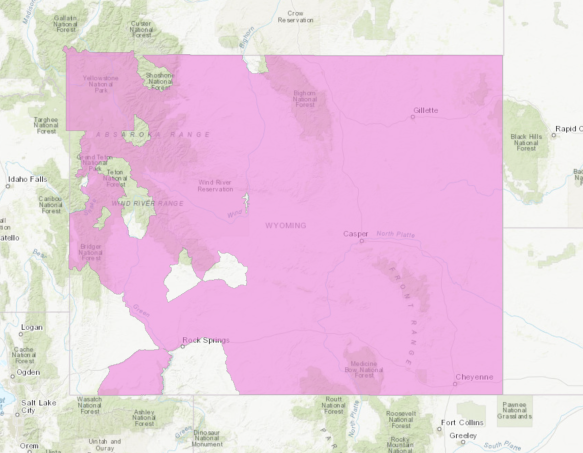
Wildlife disease distribution maps
Continually updated maps are available to understand the current distribution of certain diseases. Maps most accurately depict disease distribution, rather than intensity, as continual disease testing is not performed for all populations. Click on any of the diseases below to view its map.
Hemorrhagic Disease/Bluetongue
Highly Pathogenic Avian Influenza (HPAI)
Rabbit Hemorrhagic Disease Virus 2 (RHDV2)
Veterinary Services
Veterinary Services is a small statewide branch of the Wyoming Game and Fish Department. The branch's primary goal is to provide diagnostics, information, education, and research on wildlife disease and wildlife anesthesia to the Department and the general public. The branch employs Wildlife Veterinarians and other staff who work statewide, including at the following facilities:
Access CWD test results
You can access your results online through your sportsperson's account if you submitted a sample for Chronic Wasting Disease testing. Results are typically available within three weeks.
Find carcass disposal locations
Game and Fish regulations outline requirements for transporting and disposing of animal carcasses to prevent diseases from being moved around the state.
Branch goals
Wildlife disease is becoming one of the most challenging issues that management agencies face today. Many diseases can be shared between wildlife, domestic animals and humans. Wildlife agencies play a critical role in disease surveillance and research which can help improve the overall health of wildlife populations as well as contribute to improved health and welfare of domestic animals and humans.
Many people are surprised that biologists and game wardens need to take a class on anesthesia. In today’s world – we are seeing human populations expand into increasingly urban environments. As a result, we see more contact and conflict between the urban environment and wildlife species. Wild critters have an incredible ability to get themselves stuck in all kinds of interesting situations. Swing sets, hammocks, christmas lights, swimming pools, and fences are all at the top of the list of wildlife obstacles. Our biologists and game wardens receive regular training from Veterinary Services on how to safely sedate and handle wildlife species to help get them out of these situations and move them to safer locations.
Veterinary services works closely with wildlife biologists to conduct both captive and field research with a focus on improving the overall health and welfare of wildlife populations in Wyoming. Much of our research is focused on disease management tools and applications, development of new disease diagnostic tools and development and validation of field anesthetic protocols for wildlife.
Publications
-
Answer
Jennings-Gaines, J. E., Luukkonen, K. L., Robbins, K. M., Edwards, W. H., Vogt, N. A., Vogt, A. A., & Allen, S. E. (2022). Utilizing blood filter paper and ear punch samples for the detection of rabbit hemorrhagic disease virus 2 by RT-rtPCR. Journal of Veterinary Diagnostic Investigation, 10406387221116157.
Jennings-Gaines, Jessica E., William H. Edwards, and Timothy J. Robinson. "Determining Antibody Retention in Hemolyzed, Bacterially Contaminated, and Nobuto Filter Paper-Derived Serum Utilizing Two Brucella abortus Fluorescence Polarization Assays." The Journal of Wildlife Diseases 57.2 (2021): 386-392.
Wood, Mary E., Philip Griebel, Matthew L. Huizenga, Samuel Lockwood, Cole Hansen, Andrew Potter, Neil Cashman, John W. Mapletoft, and Scott Napper. "Accelerated onset of chronic wasting disease in elk (Cervus canadensis) vaccinated with a PrPSc-specific vaccine and housed in a prion contaminated environment." Vaccine 36, no. 50 (2018): 7737-7743.
Lowrey, Blake, Carson J. Butler, William H. Edwards, Mary E. Wood, Sarah R. Dewey, Gary L. Fralick, Jessica Jennings-Gaines et al. "A survey of bacterial respiratory pathogens in native and introduced mountain goats (Oreamnos americanus)." Journal of wildlife diseases 54, no. 4 (2018): 852-858.
Butler, C. J., Edwards, W. H., Paterson, J. T., Proffitt, K. M., Jennings-Gaines, J. E., Killion, H. J., ... & McWhirter, D. E. (2018). Respiratory pathogens and their association with population performance in Montana and Wyoming bighorn sheep populations. PloS one, 13(11), e0207780.
Miller, M. M., Cornish, T. E., Creekmore, T. E., Fox, K., Laegreid, W., McKenna, J., ... & Woods, L. W. (2017). Whole-genome sequences of Odocoileus hemionus deer adenovirus isolates from deer, moose and elk are highly conserved and support a new species in the genus Atadenovirus. Journal of General Virology, 98(9), 2320-2328
Killion, H. J., Edwards, W., Jennings-Gaines, J., Wood, M., Fox, K., & Sondgeroth, K. (2018). Development and validation of a real-time PCR specific for the leukotoxin gene of Bibersteinia trehalosi. Journal of Veterinary Diagnostic Investigation, 1040638717753497.
Grigg, J. L., Wolfe, L. L., Fox, K. A., Killion, H. J., Jennings-Gaines, J., Miller, M. W., & P. Dreher, B. (2017). Assessing Timing and Causes of Neonatal Lamb Losses in a Bighorn Sheep (Ovis canadensis canadensis) Herd via Use of Vaginal Implant Transmitters. Journal of wildlife diseases, 53(3), 596-601.
Monello RJ, Galloway NL, Powers JG, Madsen-Bouterse SA, Edwards WH, Wood ME, O’Rourke KI, Wild MA. Pathogen-mediated selection in free-ranging elk populations infected by chronic wasting disease. Proceedings of the National Academy of Sciences. 2017 Oct 30:201707807.
DeVivo MT, Edmunds DR, Kauffman MJ, Schumaker BA, Binfet J, Kreeger TJ, Richards BJ, Schätzl HM, Cornish TE. Endemic chronic wasting disease causes mule deer population decline in Wyoming. PloS one. 2017 Oct 19;12(10):e0186512.
Butler CJ, Edwards WH, Jennings-Gaines JE, Killion HJ, Wood ME, McWhirter DE, Paterson JT, Proffitt KM, Almberg ES, White PJ, Rotella JJ. Assessing respiratory pathogen communities in bighorn sheep populations: Sampling realities, challenges, and improvements. PloS one. 2017 Jul 14;12(7):e0180689.
Brennan A, Cross PC, Portacci K, Scurlock BM, Edwards WH. Shifting brucellosis risk in livestock coincides with spreading seroprevalence in elk. PloS one. 2017 Jun 13;12(6):e0178780.
Benavides JA, Caillaud D, Scurlock BM, Maichak EJ, Edwards WH, Cross PC. Estimating loss of Brucella abortus antibodies from age-specific serological data in elk. EcoHealth. 2017 May 15:1-0.
O'Brien MP, Beja-Pereira A, Anderson N, Ceballos RM, Edwards WH, Harris B, Wallen RL, Costa V, Luikart G. Brucellosis Transmission between Wildlife and Livestock in the Greater Yellowstone Ecosystem: Inferences from DNA Genotyping. Journal of wildlife diseases. 2017 Apr;53(2):339-43.
Wolfe LL, Wood ME, Nol P, McCollum MP, Fisher MC, Lance WR. The Efficacy of Nalbuphine, Medetomidine, and Azaperone in Immobilizing American Bison (Bison bison). Journal of Wildlife Diseases. 2017. Apr;53(2):304-310
Maichak EJ, Scurlock BM, Cross PC, Rogerson JD, Edwards WH, Wise B, Smith SG, Kreeger TJ. Assessment of a strain 19 brucellosis vaccination program in elk. Wildlife Society Bulletin. 2017 Mar 1;41(1):70-9.
Wood ME, Fox KA, Jennings-Gaines J, Killion HJ, Amundson S, Miller MW, Edwards WH. How Respiratory Pathogens Contribute to Lamb Mortality in a Poorly Performing Bighorn Sheep (Ovis canadensis) Herd. Journal of Wildlife Diseases. 2017 Jan;53(1):126-30.
Jennings-Gaines J, Edwards WH, Wood MA, Fox KA, Wolfe LL, Miller MW, Killion HJ. An improved method for culturing Mycoplasma ovipneumoniae from field samples. In Biennial Symposium of the Northern Wild Sheep and Goat Council 2016 (Vol. 20, pp. 83-88). Cody, Wyo, USA: Northern Wild Sheep and Goat Council.
Walsh DP, Cassirer EF, Bonds MD, Brown DR, Edwards WH, Weiser GC, Drew ML, Briggs RE, Fox KA, Miller MW, Shanthalingam S. Concordance in diagnostic testing for respiratory pathogens of bighorn sheep. Wildlife Society Bulletin. 2016 Dec 1;40(4):634-42.
Edmunds DR, Kauffman MJ, Schumaker BA, Lindzey FG, Cook WE, Kreeger TJ, Grogan RG, Cornish TE. Chronic Wasting Disease Drives Population Decline of White-Tailed Deer. PLoS One. 2016 Aug 30;11(8):e0161127.
Kamath PL, Foster JT, Drees KP, Luikart G, Quance C, Anderson NJ, Clarke PR, Cole EK, Drew ML, Edwards WH, Rhyan JC. Genomics reveals historic and contemporary transmission dynamics of a bacterial disease among wildlife and livestock. Nature communications. 2016 May 11;7.
Clarke PR, Edwards WH, Hennager SG, Block JF, Yates AM, Ebel E, Knopp DJ, Fuentes-Sanchez A, Jennings-Gaines J, Kientz RL, Simunich M. Comparison of Buffered, Acidified Plate Antigen to Standard Serologic Tests for the Detection of Serum Antibodies to Brucella abortus in Elk (Cervus canadensis). Journal of wildlife diseases. 2015 Jul;51(3):764-8.Cross PC, Maichak EJ, Rogerson JD, Irvine KM, Jones JD, Heisey DM, Edwards WH, Scurlock BM. Estimating the phenology of elk brucellosis transmission with hierarchical models of cause‐specific and baseline hazards. The Journal of Wildlife Management. 2015 Jul 1;79(5):739-48.
Fox KA, Rouse NM, Huyvaert KP, Griffin KA, Killion HJ, Jennings-Gaines J, Edwards WH, Quackenbush SL, Miller MW. Bighorn sheep (Ovis canadensis) sinus tumors are associated with coinfections by potentially pathogenic bacteria in the upper respiratory tract. Journal of wildlife diseases. 2015 Jan;51(1):19-27.
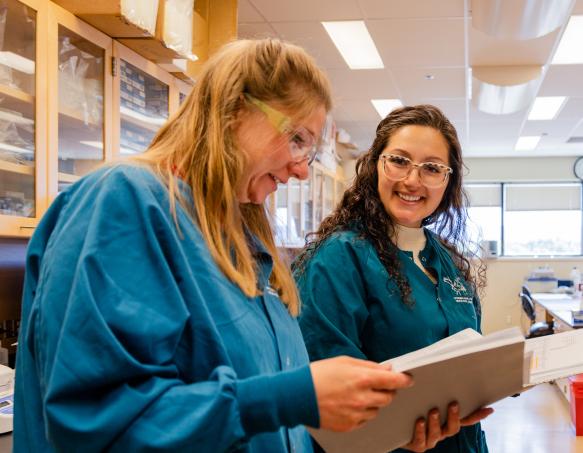
Education Opportunity
Rocky Mountain Wildlife Veterinary Externship
This collaborative approach to veterinary student training in the Rocky Mountain region is designed to provide students with broad exposure to the numerous wildlife veterinary professionals in the region.
Information about the 2024 externship, including how to apply, will be posted here when it becomes available.

